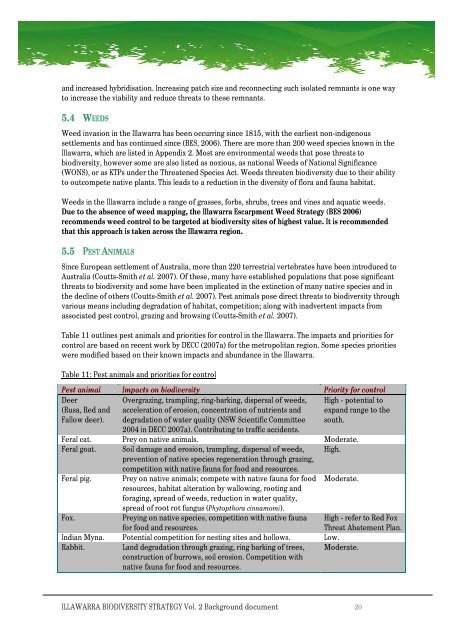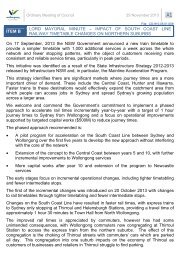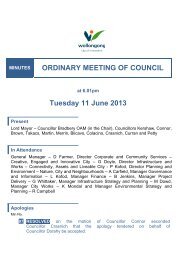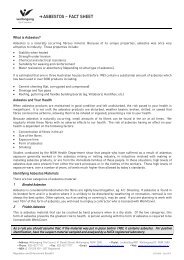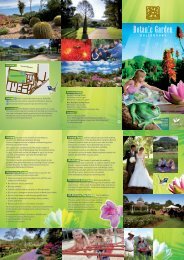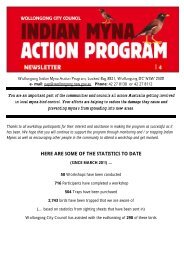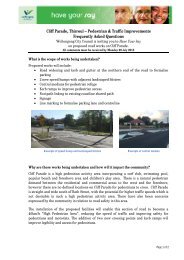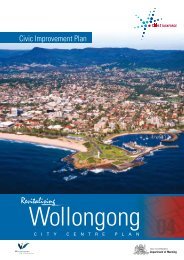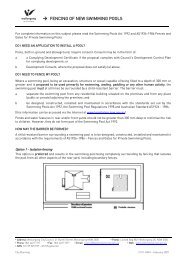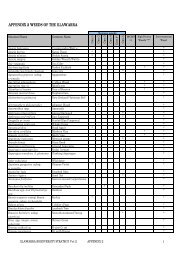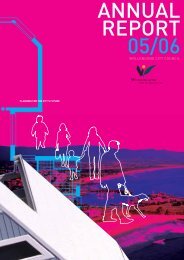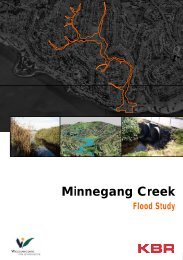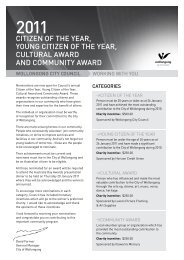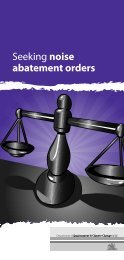ILLAWARRA BIODIVERSITY STRATEGY Vol. 2 - Wollongong City ...
ILLAWARRA BIODIVERSITY STRATEGY Vol. 2 - Wollongong City ...
ILLAWARRA BIODIVERSITY STRATEGY Vol. 2 - Wollongong City ...
- No tags were found...
Create successful ePaper yourself
Turn your PDF publications into a flip-book with our unique Google optimized e-Paper software.
and increasedhybridisation.Increasing patchsizeand reconnecting suchisolatedremnants isonewayto increase theviability and reduce threatsto these remnants.5.4 WEEDSWeedinvasionin theIllawarrahas beenoccurring since 1815,withthe earliestnon-indigenoussettlements andhascontinuedsince (BES,2006). There are more than 200 weedspeciesknownin theIllawarra,which are listedin Appendix 2.Most are environmentalweeds that pose threatstobiodiversity,however some arealso listedas noxious, as national Weedsof National Significance(WONS),or asKTPs underthe ThreatenedSpecies Act.Weeds threaten biodiversity dueto theirabilitytooutcompete native plants. This leads to areductionin the diversity of floraandfauna habitat.Weeds in the Illawarra include arangeof grasses, forbs, shrubs, trees andvinesand aquatic weeds.Duetotheabsence ofweed mapping, the IllawarraEscarpmentWeedStrategy(BES2006)recommends weedcontrol tobetargetedatbiodiversity sites of highestvalue. Itis recommendedthat this approachistakenacross theIllawarra region.5.5 PEST ANIMALSSince Europeansettlementof Australia,more than 220 terrestrialvertebrates have beenintroducedtoAustralia (Coutts-Smith etal. 2007).Of these,many haveestablished populations that pose significantthreatstobiodiversity andsome have been implicated in the extinctionofmany nativespecies andinthe declineofothers (Coutts-Smith et al. 2007).Pest animalspose directthreatsto biodiversitythroughvariousmeans includingdegradationof habitat,competition; along withinadvertent impacts fromassociated pestcontrol, grazingand browsing (Coutts-Smith etal. 2007).Table 11outlinespestanimalsandprioritiesfor controlin the Illawarra. The impacts and priorities forcontrol arebasedonrecentwork by DECC (2007a) for the metropolitanregion. Some species prioritiesweremodifiedbased on their knownimpactsand abundance in the Illawarra.Table 11:PestanimalsandprioritiesforcontrolPest animal Impacts onbiodiversity PriorityforcontrolDeer(Rusa, Red andFallow deer).Overgrazing, trampling, ring-barking, dispersalofweeds,accelerationoferosion,concentration ofnutrientsanddegradationofwaterquality (NSW ScientificCommitteeHigh-potentialtoexpandrange tothesouth.2004 inDECC 2007a).Contributing to trafficaccidents.Feralcat. Preyonnative animals. Moderate.Feralgoat. Soil damage and erosion, trampling, dispersalofweeds, High.preventionof native species regenerationthrough grazing,competitionwithnative faunafor foodandresources.Feralpig. Preyonnative animals; compete withnative faunafor foodresources,habitat alterationby wallowing, rootingandforaging, spreadofweeds,reductioninwater quality,Moderate.spread ofrootrotfungus (Phytopthora cinnamomi).Fox.Preying onnativespecies, competition withnative faunafor foodandresources.Indian Myna. Potentialcompetitionfornestingsites andhollows. Low.Rabbit.Land degradation throughgrazing, ringbarkingof trees, Moderate.constructionof burrows,soil erosion.Competition withnative faunaforfood andresources.High-refer to RedFoxThreat AbatementPlan.<strong>ILLAWARRA</strong> <strong>BIODIVERSITY</strong><strong>STRATEGY</strong><strong>Vol</strong>.2Background document 20


